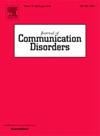Exploring cognitive predictors of language in children with developmental language disorder: The role of nonverbal IQ, working memory, implicit statistical learning, and speed of automatization
IF 2.1
3区 医学
Q2 AUDIOLOGY & SPEECH-LANGUAGE PATHOLOGY
引用次数: 0
Abstract
Children with developmental language disorder (DLD) have varied strengths and difficulties in both language and cognition but we do not yet have a comprehensive understanding as to how these abilities are interrelated. In this study, we explore performance in language typical children and children with DLD to evaluate how different areas of nonverbal cognition predict linguistic outcomes. We investigate nonverbal intelligence, working memory, implicit statistical learning, and the speed of automatization. 77 children (54 language typical children and 23 children with DLD), aged between 6;9 and 10;8 years, completed a battery of cognitive and language tasks. Our results show between-group differences in both language and cognitive abilities. We propose a cumulative risk model, suggesting that important predictors of language in children with DLD are a combination of nonverbal working memory, nonverbal intelligence, and the speed of automatization.
探索发展性语言障碍儿童的语言认知预测因素:非语言智商、工作记忆、内隐统计学习和自动化速度的作用
发展性语言障碍儿童在语言和认知方面有不同的优势和困难,但我们对这些能力是如何相互关联的还没有全面的了解。在这项研究中,我们探讨了语言典型儿童和DLD儿童的表现,以评估不同领域的非语言认知如何预测语言结果。我们研究了非语言智力、工作记忆、内隐统计学习和自动化的速度。77名年龄在6、9岁至10、8岁之间的儿童(54名语言正常儿童和23名DLD儿童)完成了一系列认知和语言任务。我们的研究结果显示了群体之间在语言和认知能力上的差异。我们提出了一个累积风险模型,表明非语言工作记忆、非语言智力和自动化速度是DLD儿童语言能力的重要预测因素。
本文章由计算机程序翻译,如有差异,请以英文原文为准。
求助全文
约1分钟内获得全文
求助全文
来源期刊

Journal of Communication Disorders
AUDIOLOGY & SPEECH-LANGUAGE PATHOLOGY-REHABILITATION
CiteScore
3.30
自引率
5.90%
发文量
71
审稿时长
>12 weeks
期刊介绍:
The Journal of Communication Disorders publishes original articles on topics related to disorders of speech, language and hearing. Authors are encouraged to submit reports of experimental or descriptive investigations (research articles), review articles, tutorials or discussion papers, or letters to the editor ("short communications"). Please note that we do not accept case studies unless they conform to the principles of single-subject experimental design. Special issues are published periodically on timely and clinically relevant topics.
 求助内容:
求助内容: 应助结果提醒方式:
应助结果提醒方式:


